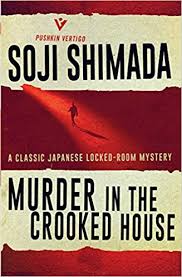
On this point, the author feels he may have been unfair to the reader. However, he believes that it will not cause any lasting damage to those with a vivid imagination.
So writes Soji Shimada in the solution chapter of his locked-room mystery, Murder in the Crooked House. Whether this is a cop out (perfectly-tuned plots need no such caveat) or a delightful admission of playfulness shall not be discussed here. What I’d like to discuss are solutions. What is acceptable?
Murder mystery fans (particularly impossible crime fanatics) are willing to bend over backwards to allow a certain amount of physical improbability. My recent reading of The Footprints of Satan was filled with moments that, had I been insistent on realism, would have turned me off immediately. In the end, I deemed them to be a hair’s breadth from the wrong side of my arbitrary limit.
What is the limit? The Stingaree Murders has a trick with a shark that is so utterly unbelievable it induced giggling from this reader. Even in the alternate universe of the mystery novel, I could not bring myself to agree that this actually happened. (To be fair, the audacity of the author was such that I enjoyed that solution far more than I should have. That novel has some other far more serious detriments.)
Why do we allow so much leeway (laws of physics) in our solutions? The answer is obvious. look at the trade-off. In Murder in the Crooked House, we get floating murderers, corpses in three locked rooms, beds that set themselves on fire…I could go on for a long time, but you get the point. It’s a wonderful journey to insanity and back.
Then comes the solution. Oh, boy. My reaction was instinctive. I felt like a jilted lover. This beautiful story of suspects confined in a house with impossible murder (my favorite set-up) had ended with an even more impossible solution. Then a funny thing happened. Perhaps it will happen to you too. I looked at the final diagram for a long time until I changed my mind. The solution makes perfect sense. To be clear, perfect poetic sense.
Sometimes, mysteries reveal events you had misinterpreted. Dialogue takes on more sinister meanings or a friendly gesture becomes murderous intent. Other times, they create myths and echoing imagery that allow for solutions which are only acceptable within the mystery’s own pages. The latter is MitCH.
The translation seems, to my mind, much better than The Tokyo Zodiac Murders. There are far less moments of awkward phrasing. The characters are well defined, and I loved the detectives clashing personalities.
MitCH is superb. I can’t recommend it highly enough. When you reach the solution, give yourself a little extra time to look at the diagram of the house. I’d be curious to know if you go through the same process I did.


I’ve just started this — about half an hour ago — so I’m curious to see what I make of it when I get there. On the first 40-some pages I’d agree about the superior translation, so let’s hope the contents live up to your billing…
LikeLike
I’d say more, but best to wait. I think you’ll have a good time.
LikeLike
I’ll email you some thoughts — plenty to talk about, and I’d hate to spoil anything on here.
LikeLike
“When you reach the solution, give yourself a little extra time to look at the diagram of the house. I’d be curious to know if you go through the same process I did.”
Sort of. When learning the solution, I immediately flipped back to the diagram of the house and, yes, the solution makes perfect sense. And I loved it!
Only major drawback of The Murder in the Crooked House is that it feels rather small-scale when compared to the macabre, grandiose plot of The Tokyo Zodiac Murders. Otherwise, this is a genuine masterpiece with a truly great and original locked room-trick.
LikeLike
Tokyo/Zodiac is one of a kind. I think a better translation would have made it a masterpiece (for English speakers). With MitCH, the overall scheme was genius even though the clue-by-clue details didn’t quite work for me. A lot of complaints could be made about withheld information, but overall I found them irrelevant to the beauty of the grand design. That’s why I had to consider the diagram for a bit.
LikeLike